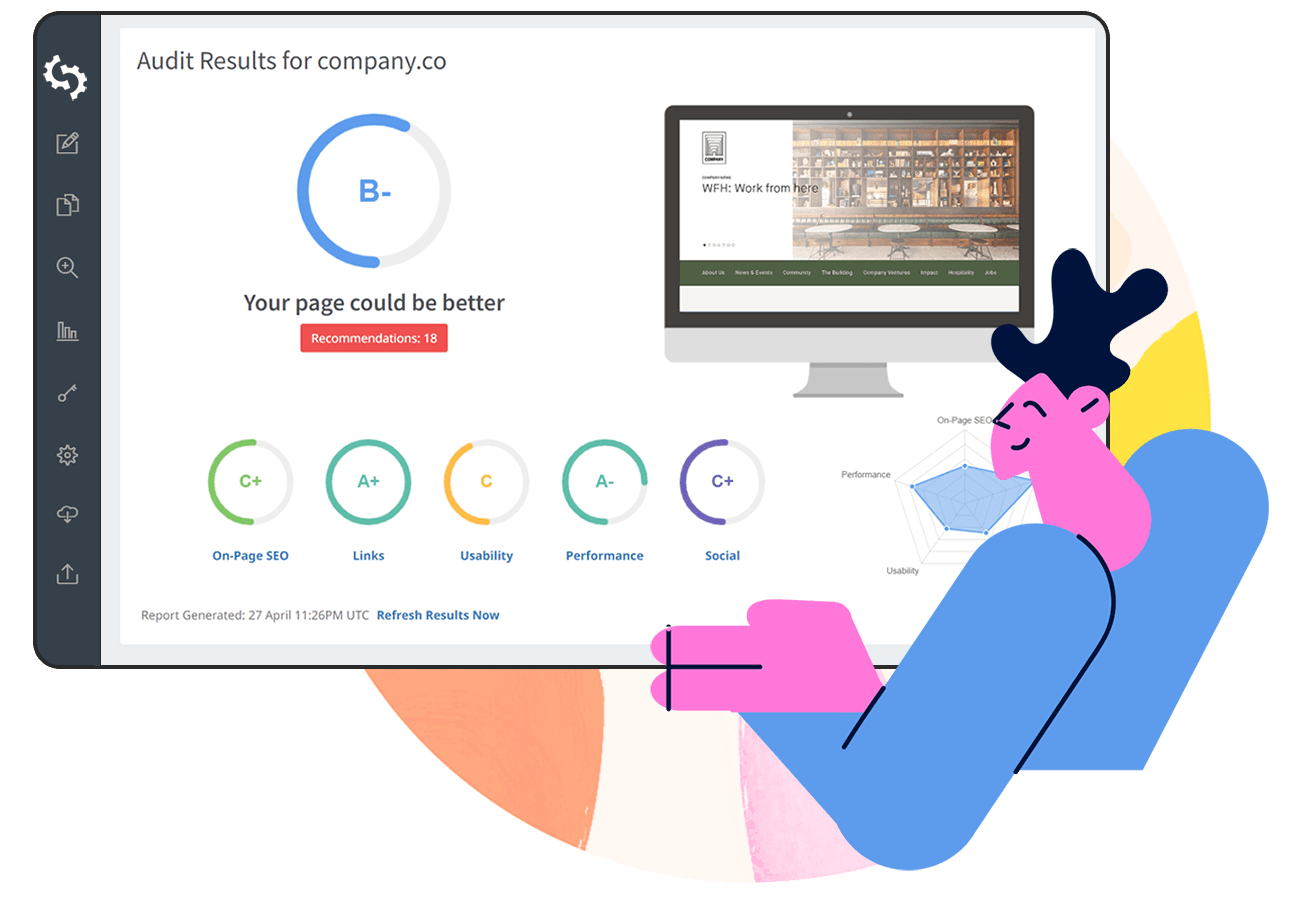
If your business is acquiring inbound links, you should really measure the value of the backlinks obtained. Link building metrics help you evaluate the overall strength of your link profile by analyzing the quality and authority of each incoming link to your domain.
By determining the actual value of backlinks, you can understand their role in improving your site authority and organic rankings.
Not measuring the potential of an inbound link can lead to a poor ROI for your link building campaigns.
In this article, I will show you the different link building metrics that you should track to judge the value of a backlink and the role it plays in boosting your overall SEO performance.
Remember, the quality of incoming links matters more than the quantity. As a result, counting the number of backlinks alone does not decide ranking power; you should also analyze the link quality.
Key Takeaways
- The quality of backlinks matters more than the number of links acquired.
- A natural backlink profile includes branded, generic, and keyword-rich anchor texts.
- Links from industry-relevant sites carry more weight than those from unrelated domains.
- Pages with fewer outbound links pass more link equity to your site.
- Various metrics, such as Domain Strength, Page Strength, and anchor text, help determine the value of a backlink.
What are Link Building Metrics?
Link building metrics are quantitative and qualitative indicators used to measure the effectiveness and value of the links you acquire for your website.
In a nutshell, they tell you about the health of your backlink profile.
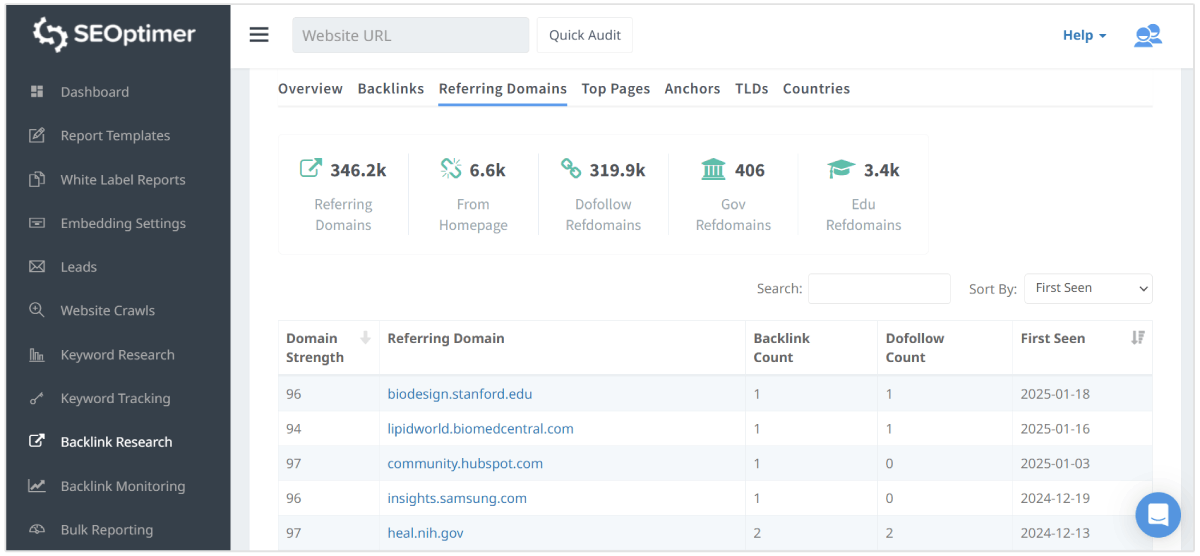
For instance, links from spammy domains degrade your link profile and might lead to Google penalties.
On the contrary, high-authority, editorial, and relevant inbound backlinks improve your domain rating and trust.
Various domain-level and page-level metrics decide the overall value of an incoming link.
Different link measurement factors determine whether a backlink from a particular domain or page is useful or not.
Why Track Link Building Metrics?
Not all backlinks are equal or beneficial. Some are excellent, some can be neutral, while others might even harm your site's reputation if they come from spam domains created specifically to deceive users and search engines.
Incoming hyperlinks from trusted domains are hard to acquire, and they fall under the highest tier of links. Similarly, backlinks from low-quality domains are easy to build and come under the lowest tier of links.
By evaluating the different metrics for link building, you can identify whether the link from a particular domain is of high-quality or low quality.
As we all know, link building is a resource-intensive process that involves time, effort, and often financial costs. If you invest in link building activities that might harm your link profile in the long run, then you are making a big mistake.
Regular analysis of link building metrics can highlight trends and patterns in your link profile, such as emerging sources of high-quality links or the growth of potentially harmful links.
By measuring the real potential of a domain and its impact on your link profile, you can gain backlinks only from useful websites. This way, you can justify your link building expenditure.
Metrics for Link Building Success
Here are the top metrics for tracking link building success:
1. Domain Strength
One of the most powerful link building metrics is Domain Strength. It measures the overall authority of a website using a combination of factors like:
- The age of the domain
- The number of unique referring domains pointing to the website
- Total linking IPs
- The quality and quantity of links pointing to the website
- Total Follow Vs Nofollow links, and other factors
Domain Strength is a site-level metric that measures the importance of the entire website. It indicates the domain’s potential to rank well in search engine results pages across a broad range of topics and keywords.
You can check the Domain Strength of any URL using SEOptimer’s Backlink Research tool.
Enter any domain in the search bar and click on Check Backlinks.
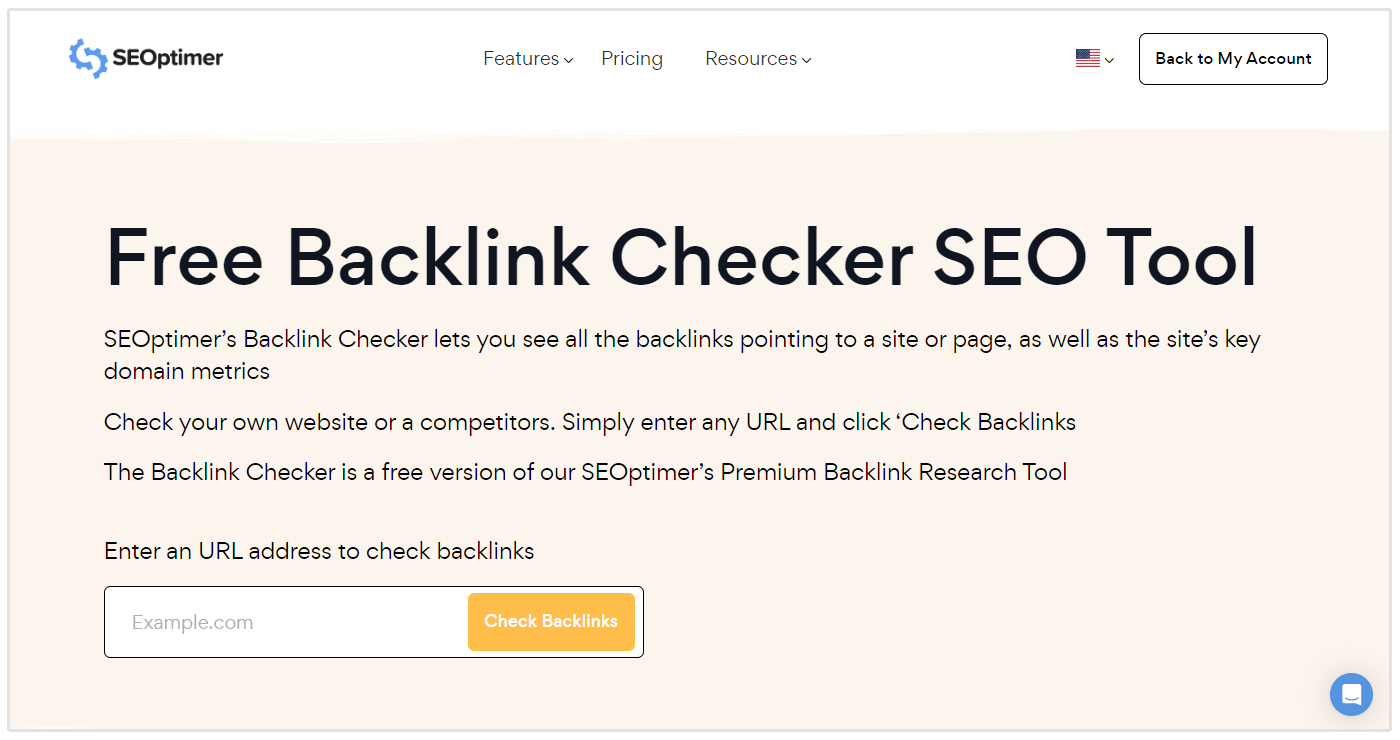
The tool will show you the Domain Strength along with other metrics like:
- Total backlinks
- Total referring domains
- Number of nofollow and dofollow backlinks
- Number of edu and gov inbound links
- Number of unique subnets and IPs
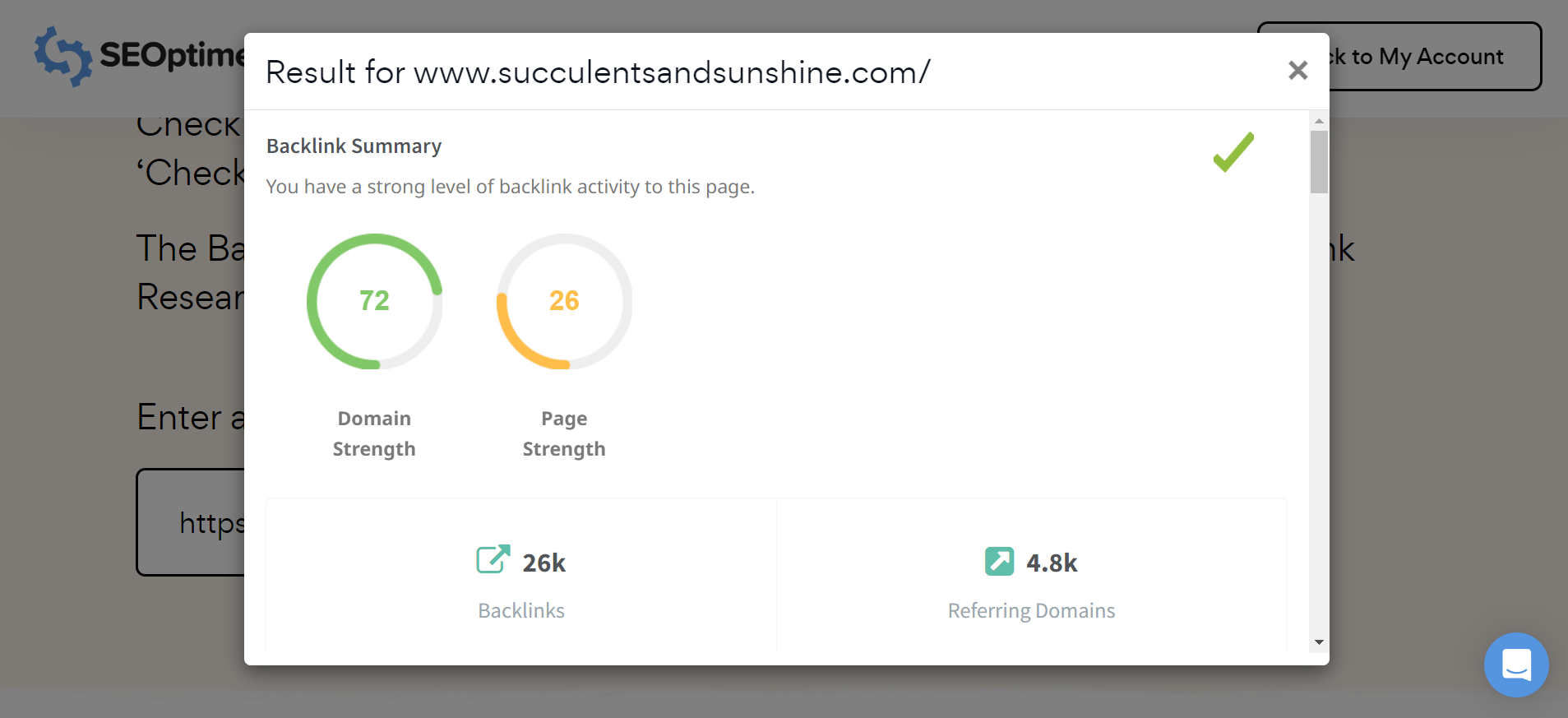
High Domain Strength suggests that new content on the site may rank better simply because it is associated with a reputable domain. It also means that links from such a domain to other sites are more valuable due to the domain's established credibility.
2. Page Strength
Page Strength measures the quality of a page that links to your domain. It is useful to measure the Page Strength to analyze the value of the actual page that has your backlink.
Page authority is specific to individual pages within a site and depends on factors such as the quality and relevance of the content on the page, the page-specific backlinks, and the use of keywords.
You can measure the strength of a webpage using the SEOptimer backlink checker tool. Follow the same process explained above, and it will tell you the Page Strength.
A high Page Strength means that the particular page has a good chance of ranking well for targeted queries. It's an indicator that the page is seen as valuable and relevant for specific topics or keywords.
3. Anchor Text
A natural link profile contains a diverse range of anchor texts, including branded, exact match, partial match, and generic phrases.
Over-optimization of keyword-rich anchor text can appear manipulative to search engines, and might lead to algorithmic and manual penalties.
If a website has an excessive number of outbound anchor links pointing to non-white-hat niches (such as gambling, payday loans, or adult content), it signals potential link-selling behavior and reduces its credibility.
- Dmytro Sokhach, Search Engine Enthusiast and CEO at Editorial.Link
Using your brand name as anchor text can reinforce your brand recognition and contribute to a natural link profile. It's particularly effective for backlinking in press releases, sponsored content, or partnerships.
You should diversify anchor text types, such as:
- Generic anchor text (e.g., "click here," "read more")
- Naked URLs (e.g., "www.seoptimer.com")
- Partial-match keywords (where the anchor includes a variation of the main keyword)
- Related keywords (keywords that are related but not exactly the same as those you're targeting)
Also, you should link to deep, relevant content. Instead of always linking to your homepage, use anchor text to link deeper into your site to relevant pages that offer value to the reader.
This way, you can distribute page authority throughout your site and improve the user experience.
You can identify the anchor texts pointing to your domain using the our Backlink Checker Tool. Just follow the same steps as above and you'll see the anchor texts of all of your top backlinks.
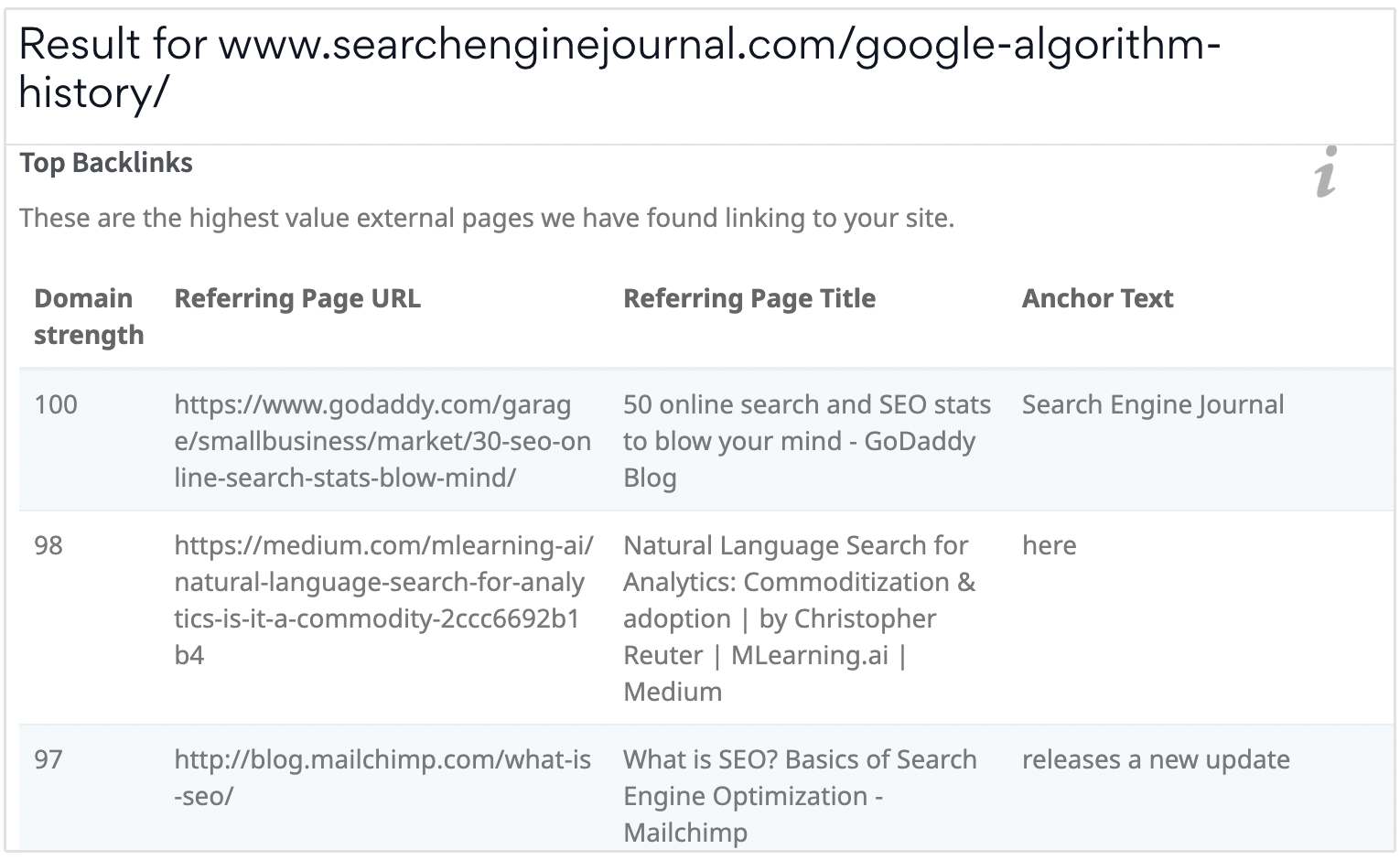
As you can see in the above screenshot, the tool shows the Domain Strength, the Referring Page URL, the Referring Page Title, and the Anchor Text.
The above example of the Search Engine Journal’s link profile is also a good example of how your anchor texts should look.
A natural and spam-free backlink profile with generic, branded, and natural anchors will keep your domain safe from any future penalties from algorithm changes.
The tool also shows a list of Top Anchors by Backlinks. By looking at this data, you can have a good idea of the type of anchors to avoid using in your link building campaign if they are used too much.
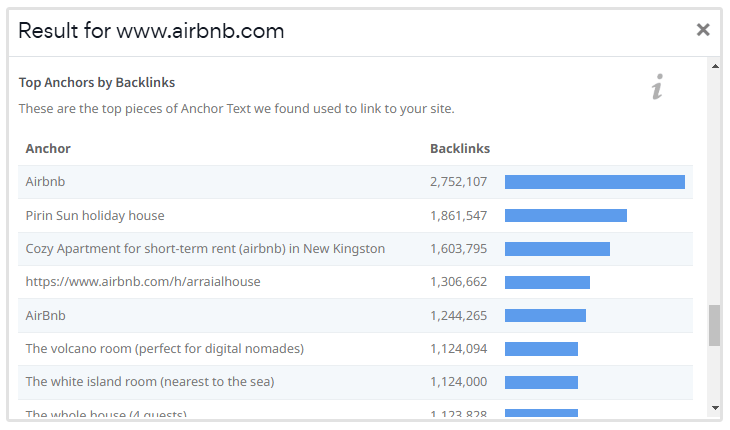
4. Page Relevance
Page relevance measures the similarity of your content to your industry. The presence of similar or related keywords indicates that the content is relevant to your niche.
Analyze whether the page targets a similar audience and serves a similar purpose as your own content. Pages that cater to the same demographic are more likely to be the most relevant.
A linking site that's from the same or similar industry as yours will hold more value than a link from an unrelated industry.
Relevant niche shows contextual relevancy and trustworthiness.
- Kimberley McConnery, Director of Link Building Operations at Sure Oak
For instance, in the case of SEOptimer, a link from publications such as Search Engine Journal or Search Engine Roundtable is a lot more relevant than a social media marketing site such as Social Media Examiner.
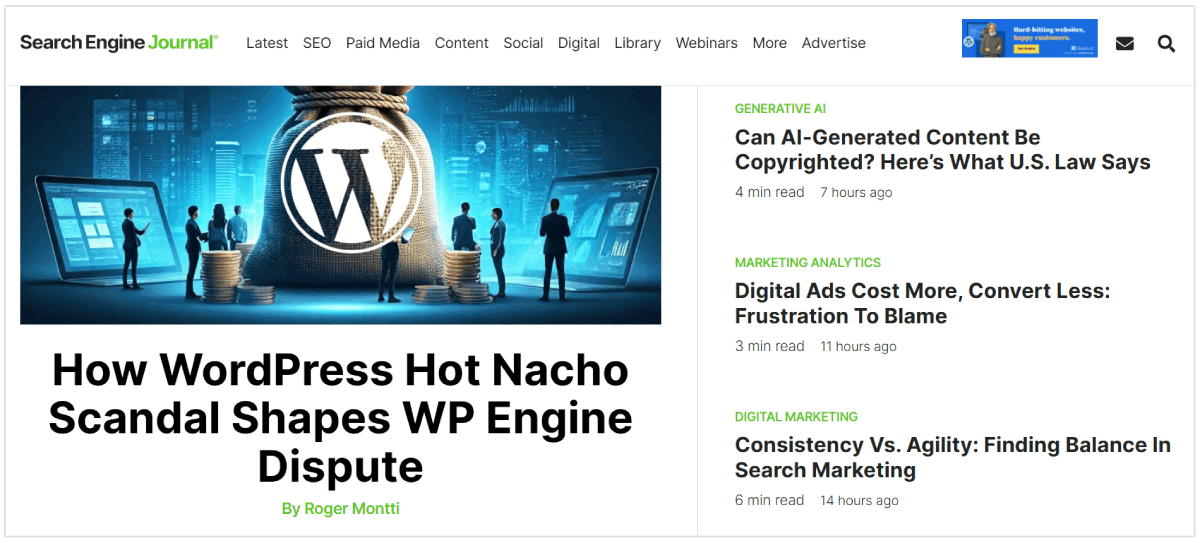
While tools provide quantitative data, there is no substitute for manually reviewing a page to understand its relevance. Read the content, assess the site's focus, and check the other topics covered on the site.
Review the content of the page for quality and context. The content should be well-written, authoritative, and should provide useful information for your target audience.
You should also check who is writing the content. Are they an expert in the field?
You can also analyze the type of sites that link to the page. A relevant page usually has backlinks from other sites within the same industry or niche.
A domain having inbound links from relevant country-specific domains is a good indicator that the website’s content is geographically relevant.
The other type of relevance for a link is geographic relevance. That is a link coming from a website that is geographically relevant to a page.
Depending on what the goal of the website is this can be pointed at a city page, or a home page, but I recommend pointing it at the most relevant page possible to get the most out of the link.
- Carradean Farley, Co-Founder at Periscope Media
5. Number of Links on Page
If you build links from pages having a low number of outbound links, greater link equity will be passed to your website.
Therefore, you should always pick pages for niche link edits or guest blog content with a low number of hyperlinks (both internal and external).
You can check the number of external and internal links on a page with the help of a tool like the Small SEO Tools Website Link Count Checker.
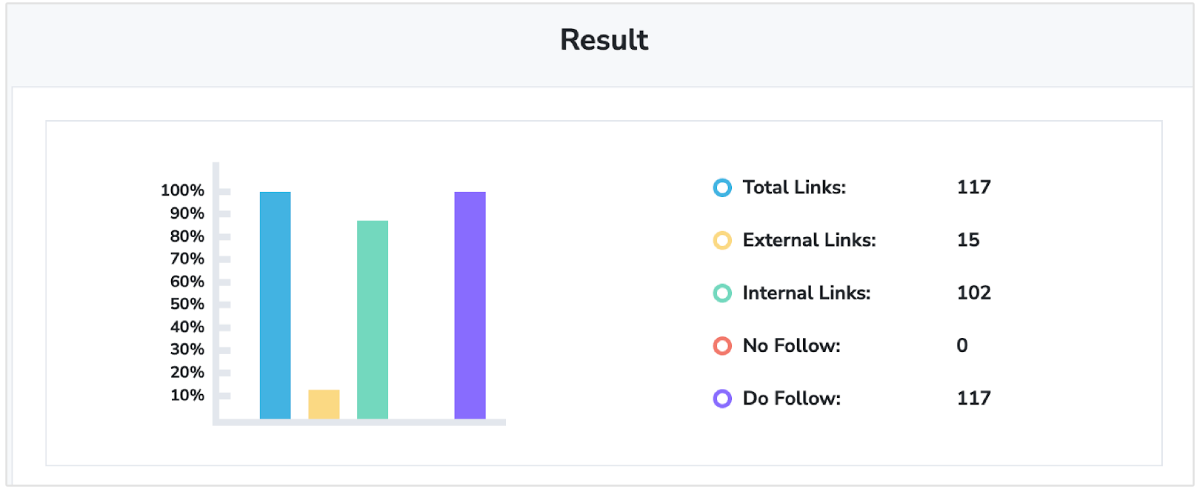
Enter the page URL, and the tool will show you the following:
- The total links count
- The number of external links
- The number of internal links
- The number of nofollow links
- The number of dofollow links.
Once you have this data, you can pick pages with a low outbound count and dofollow links. Doing so will help you improve your domain reputation as more link juice will be passed to your backlink.
6. Link Position on Page
Where your links are placed on a page determines how valuable the backlink is.
Contextual hyperlinks within the main content are considered more valuable than those in the header, footer, or sidebar.
Also, in-content links placed above the fold (the portion of the web page visible without scrolling) receive more visibility and clicks, potentially increasing their value.
Search engines, including Google, give more weight to external links as they are editorially given and contextually relevant.
You can visually inspect the webpage to see where the link is placed. Check if it's in the main content, sidebar, footer, or header.
Chrome's Developer Tools lets you inspect the HTML and see where the link is coded within the page structure.
When determining link position on the page, make sure they look natural. In-content hyperlinks should add value to the reader and must fit seamlessly into the text.
Google's algorithms have evolved to prioritize user experience and the natural flow of content. Google advises against manipulative link practices and stresses the importance of link quality and relevance over mere placement.
Avoid participating in link schemes designed to manipulate page rank by artificially placing links in certain positions.
Also, do not place links where they can get lost in a sea of other links, such as crowded footers and sidebars, which are devalued by search engines.
7. Dofollow vs Nofollow
Dofollow hyperlinks pass on link equity (the power to rank on search engines). Every link is a dofollow link unless it is specifically marked as nofollow.
Nofollow links, introduced by Google in 2005 to combat spam, do not pass on link equity. They are used to instruct search engines to disregard the link in terms of passing ranking power.
However, they can still bring traffic and carry non-SEO value, such as brand exposure and credibility.
If you are running a link building campaign, most links should be dofollow. However, the actual ratio of dofollow links depends on your overall link profile.
Overall, an ideal ratio of 80:20 or 70:30 is advisable, where 80% or 70% should be dofollow links.
You should always use "nofollow" or "sponsored" attributes for links that are advertisements or paid placements to comply with Google’s guidelines.
Editorial dofollow links are among the most valuable types of links. You can acquire them by creating high-quality content that your target audiences will link to or by publishing guest blogs on reputable sites.
Google's algorithms are designed to identify and penalize sites that attempt to manipulate their search rankings through unethical link practices, such as having an unnaturally high percentage of dofollow links.
Algorithmic penalties can result in a drop in rankings, while manual penalties can result in the removal of the entire domain from the Google index.
8. Referring Page Traffic and Rankings
A backlink isn’t just about the referring domain's authority—it’s also about whether the linking page is actually visible in the search results and getting traffic.
A backlink from a high-ranking, high-traffic page carries significantly more SEO value than one from a page that barely gets any visitors.
According to Miguel Salcido from Organic Media Group, this is one of the most important metrics for successful link building.
And the most important metrics in determining the authority of a given link are the number of keyword rankings that the domain you are getting the link from has, as well as the amount of estimated organic traffic the domain gets from those rankings.
If you get a link from a site that has lots of organic visibility, one can safely assume that the domain is in good standing with Google. Not only that, but you also stand a good chance at getting actual traffic from that link because of this.
- Miguel Salcido, CEO & Founder at Organic Media Group
So when you're evaluating which domains to get links from, be sure to actually check whether the page is at least ranking on the first page of Google.
You can easily do this by plugging the intended URL into our Keyword Research Tool and by using the Search By URL option.

Our tool will then show you all of the keywords that the URL is ranking for, along with their position and estimated traffic per month.
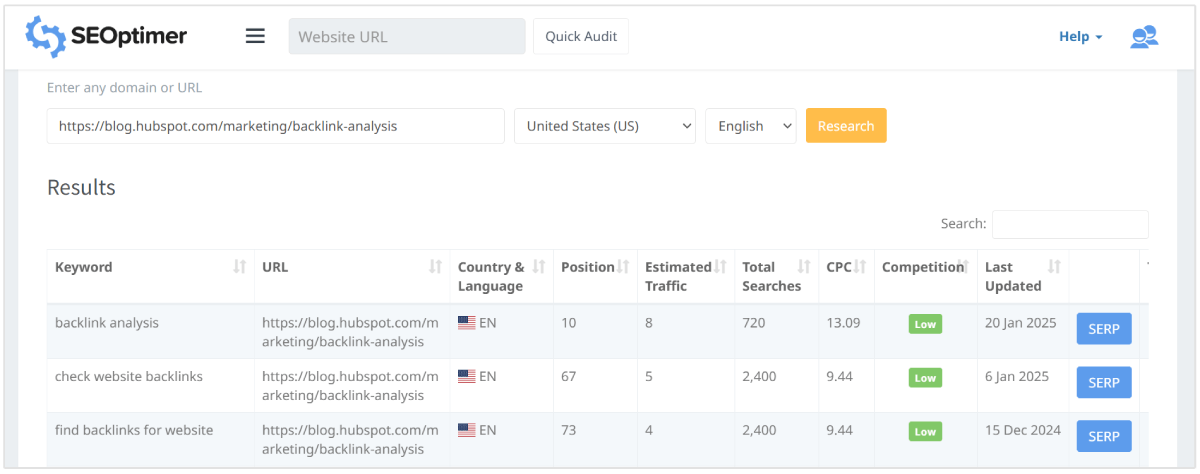
How to Measure Link Building Success
Monitor the SEO rankings for the specific pages to which you have built links. You can track rankings with the help of the SEOptimer's rank tracking tool.
![]()
With this tool, you can benchmark the organic positionings of the keywords before the start and after the end of your link building campaign.
As well as compare the improvements or declines in rankings to know whether the built backlinks actually contributed to SEO success.
![]()
You should also compare the Domain Strength before and after the start of the campaign. A rise indicates a positive ROI.
You can check Domain Strength using either the Backlink Checker tool or run a quick website audit tool to get a brief overview of your backlink metrics.
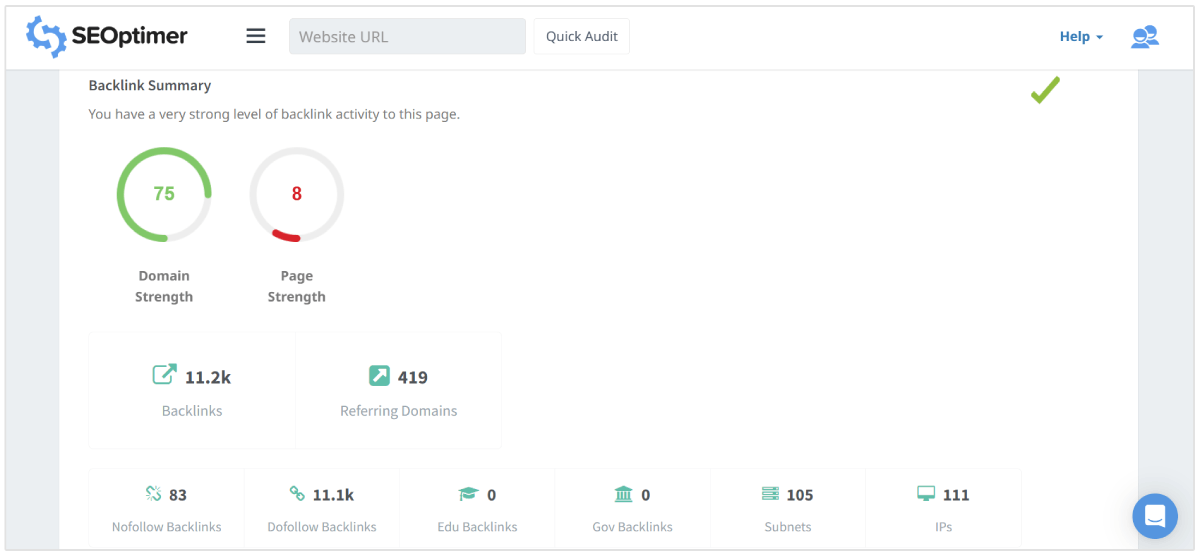
You should also compare the increase or decrease in the number of dofollow backlinks, total backlinks, and referring domains. Successful link acquisition campaigns should lead to an increase in all these three SEO link metrics.
Metrics for Link Building FAQs
How often should you track link building metrics?
You should have a basic monthly check of link building metrics to understand the impact of your link building efforts.
A detailed link profile analysis should be performed every quarter to compare the growth in the number of dofollow backlinks, the quality of these links, and their impact on your overall SEO goals, such as an increase in keyword rankings.
Link building metrics should also be tracked after you have just completed a significant link building campaign like niche link edits or guest blogs. Evaluating the metrics helps you measure the success of the campaign.
Also, if you notice unexpected changes in your search engine rankings after major ranking algorithm changes, you should thoroughly analyze your link profile.
With our Backlink Monitoring tool you can easily track link building metrics.
This tool sends you weekly updates on new and lost backlinks, giving you a detailed overview of changes to your backlink profile.
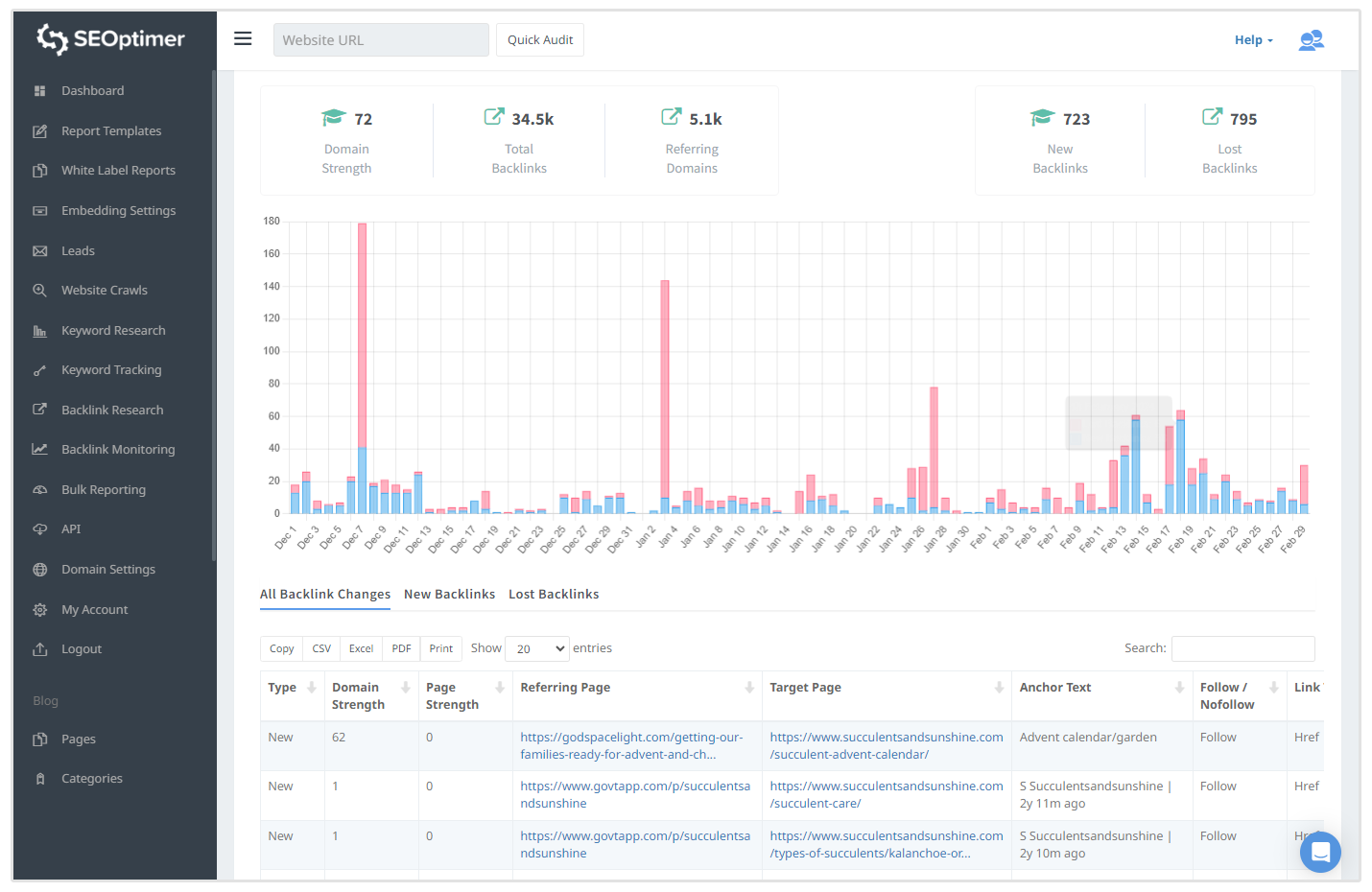
What is the difference between Page Strength and Domain Strength?
Domain Strength measures the cumulative credibility of all pages under a domain, whereas Page Strength evaluates the effectiveness of individual pages.
While both are important, Domain Strength boosts the ranking potential of all pages on the site, whereas Page Strength affects only the specific page’s ability to rank.
Conclusion
Tracking the right metrics for link building is essential to ensure the effectiveness of your SEO strategies.
Understanding the quality, quantity, and relevancy of backlinks, along with the authority of the referring domains, provides a comprehensive view of how these links bolster your site’s credibility and contribute to improved organic rankings.
Moreover, calculating the top link building metrics allows you to optimize your efforts, prioritize high-quality editorial links that offer the best return, and avoid strategies that may harm your SEO performance.
By focusing on the above-explained key link building metrics, you can refine your approach to secure a strong link profile that drives significant traffic and strengthens your website’s authority.
